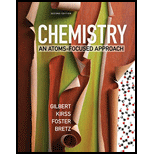
To find:
When
Answer to Problem 16.53QA
Solution:
When
Explanation of Solution
1) Concept:
The number of equivalence points depends on the number of protons that can dissociate from the molecule in an aqueous form.
Ascorbic acid is a weak diprotic acid, i.e., there are two protons that can dissociate from one molecule of ascorbic acid. The dissociation of protons occurs stepwise.
The first equivalence point occurs where the first dissociated proton is completely neutralized when titrated with a strong base
The second equivalence point occurs where both dissociated protons are fully neutralized, and the equation is
Equation for the complete titration is
Therefore, there are two equivalence points in the titration of ascorbic acid with
The volume of NaOH required to reach the second equivalence point is double the required volume of NaOH for the first equivalence point.
At equivalence point, the equal moles of weak acid and strong base react and undergo neutralization.
2) Formula:
i)
ii)
iii)
iv)
3) Given:
i)
ii) Volume of
iii)
iv)
v)
vi)
vii)
4) Calculation:
Converting the volume in mL to L,
Calculating the moles of
At first equivalence point, moles of
Set up the RICE table to determine the reacted moles of
| Reaction | + | + | |||||
| Initial | 0 | ||||||
| Change | |||||||
| Final | 0 | ||||||
Calculation of
After first equivalence point, total volume of solution is
Molarity of
| Reaction | + | + | |||||
| Initial | 0 | 0 |
|||||
| Change | |||||||
| Final | |||||||
For simplification, we assume the value of
Refer Figure 16.5 from the text book for the colors of indicators. Therefore, to indicate first equivalence point, bromthymol blue indicator can be used.
For the second equivalence point,
| Reaction | + | + | |||||
| Initial | 0 | ||||||
| Change | |||||||
| Final | 0 | ||||||
Total volume of solution after the second equivalence point, i.e., complete titration is
Calculating the concentration of
The dissociation equation is
Set up the RICE table to determine
| Reaction | + | + | ||||||
| Initial | 0 | 0 | ||||||
| Change | ||||||||
| Final | ||||||||
Calculating
Refer Figure 16.5 from the text book for the colors of indicators. The
Conclusion:
Calculate the
Want to see more full solutions like this?
Chapter 16 Solutions
Chemistry: An Atoms-Focused Approach (Second Edition)
 ChemistryChemistryISBN:9781305957404Author:Steven S. Zumdahl, Susan A. Zumdahl, Donald J. DeCostePublisher:Cengage Learning
ChemistryChemistryISBN:9781305957404Author:Steven S. Zumdahl, Susan A. Zumdahl, Donald J. DeCostePublisher:Cengage Learning ChemistryChemistryISBN:9781259911156Author:Raymond Chang Dr., Jason Overby ProfessorPublisher:McGraw-Hill Education
ChemistryChemistryISBN:9781259911156Author:Raymond Chang Dr., Jason Overby ProfessorPublisher:McGraw-Hill Education Principles of Instrumental AnalysisChemistryISBN:9781305577213Author:Douglas A. Skoog, F. James Holler, Stanley R. CrouchPublisher:Cengage Learning
Principles of Instrumental AnalysisChemistryISBN:9781305577213Author:Douglas A. Skoog, F. James Holler, Stanley R. CrouchPublisher:Cengage Learning Organic ChemistryChemistryISBN:9780078021558Author:Janice Gorzynski Smith Dr.Publisher:McGraw-Hill Education
Organic ChemistryChemistryISBN:9780078021558Author:Janice Gorzynski Smith Dr.Publisher:McGraw-Hill Education Chemistry: Principles and ReactionsChemistryISBN:9781305079373Author:William L. Masterton, Cecile N. HurleyPublisher:Cengage Learning
Chemistry: Principles and ReactionsChemistryISBN:9781305079373Author:William L. Masterton, Cecile N. HurleyPublisher:Cengage Learning Elementary Principles of Chemical Processes, Bind...ChemistryISBN:9781118431221Author:Richard M. Felder, Ronald W. Rousseau, Lisa G. BullardPublisher:WILEY
Elementary Principles of Chemical Processes, Bind...ChemistryISBN:9781118431221Author:Richard M. Felder, Ronald W. Rousseau, Lisa G. BullardPublisher:WILEY





